Combo Course
Music Production + Sound Engineering
Music Production
+
Sound Engineering
DIPLOMA IN
Music Production + Sound Engineering
Music Production
+ Sound Engineering
Curriculum
Module – 1
- All the Major & Minor scale
- Harmony/ Chords/Triads and Types
- Inversion of Chords and their Use
- Relative Major and Minor Scale
- Family of Chords
- Harmonic/Chord Progression
- Ear training
- Staff notation
- Sight Reading
- Compass of instruments
Module – 2
- Time Signature
- Understanding and Working out with the Simple and Compound Time Signature
- Syncopation
- Rhythm Notation
- Working with melodies and countermelodies
- Harmonisation
- Voicing
- Transposition
- Music Modulation and types
- Using Pedal Point,Altered Bass Chords,Chord Leading Rules,Chords Substitution.
- Song Writing on Staff Notation
- Understanding about the Common Forms.
- Multi instrument and Multi output
- Native Instruments Kontakt 7 & Libraries
- Spectrasonics Omnisphere,Trilian, Keyscape
- Best Service Engine & Libraries
- UVI Workstation & Libraries
- Swar Systems Swarplug
- Ample Guitar & all Libraries
- Ujam & all Libraries
- XLN audio addictive drums, ToonTrack Superior Drummer
- Refx Nexus
- Synthesis (Additive,Subtractive,Fm,Granular)
- Hardware Synthesiser
- Software Synthesizer ( Falcon 2, Serum, Sylenth, Massive, Ana 2, Spire)
- Wavetable
- LFO
- Filters (HI & Low Pass,Bandpass, Notch)
- Envelopes (Attack,Decay,Sustain,Release)
- Oscillator
- Vocoder Synth
- Monophonic,Polyphonic,Ensemble Synth
- Vocal Recording & Voice Sound Processing
- Acoustic Drums Recording
- Acoustic & Electric Guitar Recording
- Recording, Punch in Recording,Multi track recording audio track
- Vocal Harmonies Stack Creation & Sound Processing.
- Introduction of Acoustic & Electric Guitar & playing style
- Understanding the Programing Process of Acoustic & Electric Guitar (Strum, Lead, Arpeggios, Riff Etc)
Understanding the Programing Process of Nylon & Ukulele(Strum, Lead, Arpeggios, Riff, etc) - Detailed understanding of Ample Guitar, Kontakt, Ujam and other Guitar Vst Plugins And Libraries
- Appropriate Sound Processing Treatment On The Sample Sound Libraries to make it Sound Real(Acoustic & Electronic)
- Introduction of Acoustic Drum and Electronic Drum Kit
- Programing Different Types of Grooves in Simple & Compound Time Signature(Acoustic & Electronic)
- Making your Own Drum Kit by using different sample sound libraries (Acoustic & Electronic)
- Appropriate Sound Processing Treatment on the sample sound libraries to make it Sound Real(Acoustic & Electronic)
- Ethnic & World Percussions Programming (Darbuka, Djembes, Bongos, Cajons, Cabasa, Congas, etc)
- Indian Rhythm Programming (Dhol, Dholak, Tabla, Duff, Shakers,etc)
- Electronic Dance Music Rhythm Programing (Electro House, Deep House, Big room, Synthwave, Hiphop, Future pop, Trap etc)
- Orchestral Drums Programming
- Pop, Rock Drums Programming (Acoustic & Electronic)
Part – 1 Essential Skills
- Concept
- Structuring the arrangement
(what goes where and why) - Harmonising with chords,progressions and substitutions
(working with the harmonic background of an arrangement) - Utilising voicing and voice leading
(choosing the order of notes within a chord-and from chord to chord) - Working with melodies and countermelodies
- Deciding on the right instrumentation
(choosing which instrument play which note)
Part – 2 Instruments And Voices; Ranges And Techniques
- String instruments
(writing for both bowed and plucked strings) - Brass instruments
(writing for concert,marching, and drum corps brass) - Woodwind instruments
(writing for single reed,double reed, and flute-like instrument) - Keyboard and electronic instruments
(writing for the piano,organ,synthesiser and similar instruments) - Percussion instrument
(writing for drums and mallets) - Voices (writing for sopranos,alto, tenor, basses and other voices)
- String instruments
Part – 3 Real World Arranging
- Arranging for an orchestra (creating symphonic pieces for the full orchestra)
- Arranging for a choir (creating vocal arrangement in stab fashion)
- Arranging for a rhythm section(writing in different styles and for different rhythm sections instruments)
- Film Scoring is related to providing background music in films, albums, etc.
- For students looking to make a career in the film industry, this module will be proven as a milestone to getting familiar with how background music works and the process of music scoring.
- Scoring Music for Feature Films , Short Films, OTT Platforms, Advertisements,etc.
- Understanding The Director’s Point of View..
- Importance of the Time Line & The Delivery
- Film Mixdown & Export..
- Overview of Logic Pro X , Ableton Live, Cubase Pro 12
- Tools,Channel Strips,Vst & Effect Plugins
- Quantise Midi notes and Flex Audio
- Midi Editor,Midi Transform and trigger Midi from Logic
- Vocal tuning using Flex,Wavetuner,Auto Tuner
- Recording, Punch in Recording, Multi track recording audio track
- Automation Audio & Midi
- Midi Controller Using FaderPort16
- Understanding and working with the Busses
- Summing & Routing with the Busses
- Vocoder and Vocal Production
- Understanding Compressor,Reverb, Delay, Equaliser
- Side chain techniques single and overall track
- Melodyne
- Understanding the Concept of Sampler
- Use of Different Sample
- Rewire
- Project Alternatives,Metadata
- Real Time & Offline Bouncing,Sample rate,Bitrate
- Understanding the Score Editor
- Parallel Compression,Reverb & Delay Techniques.
- Music Composition will help you achieve a perfectly finished music tune from a bunch of loops.
- Includes various elements like rhythm, beats, harmony, applying vocals, finishing, etc.
- Helps you enhance the skills like making the right phrasing of the tune, calculation of notes in any particular phrase, commercial value in a tune, etc.
- Songwriting and lyrics writing is closely knitted with music production. In this module, you will learn through analysis, examples, and sessions to compose and write songs in different genres. Highlights of this module include basic skills of lyrics writing, arranging your original compositions, and producing them.
- Equaliser(EQ)
- Compressor
- Reverb
- Delay
- Noise Gate
- Distortion
- Saturation
- Gain Staging
- Stereo Imaging
- Slate Digital Plugin Bundle
- Plugin Alliance Plugin Bundle
- Universal Audio Plugin Bundle(UAD)
- Solid State Logic Plugin Bundle(SSL)
- FabFilter
- Sound Theory Gullfoss
- Oeksound Soothe 2
- Izotope Plugin Bundle
- Waves Plugin Bundle
- The stage where you assemble the song structure. You’ll develop the intro, verses, bridge, choruses, breakdowns, and outro. It involves adding and subtracting different instruments throughout the song.
- Arrangement pattern for all different genres like Rock,Pop,Contemporary, Hip Hop, EDM, Orchestral, Bollywood, Rap Song, etc.
- Introduction of Acoustic & Electric Guitar Bass Guitar & playing Style
- Creating Groove with the Bass-line( All Genre)
- Understanding the Programming Process of Sub, Grunge, Slap,Fingered, etc
- Detailed understanding of Ample Guitar, Konkatk, Ujam and other Guitar VST Plugins and libraries.
- Appropriate Sound Processing Treatment on the Sample Sound Libraries to make it sound real(Acoustic & Electronic)
- Introduction of Stroke Instruments
- Programming Rabab, Mandolin, Dobro, Banjo, Oud,etc..
- Programming Santoor, Sitar,Sarod, Tanpura, Harmonium, etc..
- Appropriate sound processing treatment on the sample sound libraries to make it sound real.
- History of Music Business
- Functions of a Record Label
- Introduction to Intellectual Property Rights
- Copyrights & Agreements
- Online Music Business
- Management of Content & Aggregators
Module – 1
- All the Major & Minor scale
- Harmony/ Chords/Triads and Types
- Inversion of Chords and their Use
- Relative Major and Minor Scale
- Family of Chords
- Harmonic/Chord Progression
- Ear training
- Staff notation
- Sight Reading
- Compass of instruments
Module – 2
- Time Signature
- Understanding and Working out with the Simple and Compound Time Signature
- Syncopation
- Rhythm Notation
- Working with melodies and countermelodies
- Harmonisation
- Voicing
- Transposition
- Music Modulation and types
- Using Pedal Point,Altered Bass Chords,Chord Leading Rules,Chords Substitution.
- Song Writing on Staff Notation
- Understanding about the Common Forms.
- Overview of Logic Pro X , Ableton Live, Cubase Pro 12
- Tools,Channel Strips,Vst & Effect Plugins
- Quantise Midi notes and Flex Audio
- Midi Editor,Midi Transform and trigger Midi from Logic
- Vocal tuning using Flex,Wavetuner,Auto Tuner
- Recording, Punch in Recording, Multi track recording audio track
- Automation Audio & Midi
- Midi Controller Using FaderPort16
- Understanding and working with the Busses
- Summing & Routing with the Busses
- Vocoder and Vocal Production
- Understanding Compressor,Reverb, Delay, Equaliser
- Side chain techniques single and overall track
- Melodyne
- Understanding the Concept of Sampler
- Use of Different Sample
- Rewire
- Project Alternatives,Metadata
- Real Time & Offline Bouncing,Sample rate,Bitrate
- Understanding the Score Editor
- Parallel Compression,Reverb & Delay Techniques.
- Multi instrument and Multi output
- Native Instruments Kontakt 7 & Libraries
- Spectrasonics Omnisphere,Trilian, Keyscape
- Best Service Engine & Libraries
- UVI Workstation & Libraries
- Swar Systems Swarplug
- Ample Guitar & all Libraries
- Ujam & all Libraries
- XLN audio addictive drums, ToonTrack Superior Drummer
- Refx Nexus
- Music Composition will help you achieve a perfectly finished music tune from a bunch of loops.
- Includes various elements like rhythm, beats, harmony, applying vocals, finishing, etc.
- Helps you enhance the skills like making the right phrasing of the tune, calculation of notes in any particular phrase, commercial value in a tune, etc.
- Songwriting and lyrics writing is closely knitted with music production. In this module, you will learn through analysis, examples, and sessions to compose and write songs in different genres. Highlights of this module include basic skills of lyrics writing, arranging your original compositions, and producing them.
- Synthesis (Additive,Subtractive,Fm,Granular)
- Hardware Synthesiser
- Software Synthesizer ( Falcon 2, Serum, Sylenth, Massive, Ana 2, Spire)
- Wavetable
- LFO
- Filters (HI & Low Pass,Bandpass, Notch)
- Envelopes (Attack,Decay,Sustain,Release)
- Oscillator
- Vocoder Synth
- Monophonic,Polyphonic,Ensemble Synth
- Equaliser(EQ)
- Compressor
- Reverb
- Delay
- Noise Gate
- Distortion
- Saturation
- Gain Staging
- Stereo Imaging
- Slate Digital Plugin Bundle
- Plugin Alliance Plugin Bundle
- Universal Audio Plugin Bundle(UAD)
- Solid State Logic Plugin Bundle(SSL)
- FabFilter
- Sound Theory Gullfoss
- Oeksound Soothe 2
- Izotope Plugin Bundle
- Waves Plugin Bundle
- Vocal Recording & Voice Sound Processing
- Acoustic Drums Recording
- Acoustic & Electric Guitar Recording
- Recording, Punch in Recording,Multi track recording audio track
- Vocal Harmonies Stack Creation & Sound Processing.
- The stage where you assemble the song structure. You’ll develop the intro, verses, bridge, choruses, breakdowns, and outro. It involves adding and subtracting different instruments throughout the song.
- Arrangement pattern for all different genres like Rock,Pop,Contemporary, Hip Hop, EDM, Orchestral, Bollywood, Rap Song, etc.
- Introduction of Acoustic & Electric Guitar & playing style
- Understanding the Programing Process of Acoustic & Electric Guitar (Strum, Lead, Arpeggios, Riff Etc)
Understanding the Programing Process of Nylon & Ukulele(Strum, Lead, Arpeggios, Riff, etc) - Detailed understanding of Ample Guitar, Kontakt, Ujam and other Guitar Vst Plugins And Libraries
- Appropriate Sound Processing Treatment On The Sample Sound Libraries to make it Sound Real(Acoustic & Electronic)
- Introduction of Acoustic & Electric Guitar Bass Guitar & playing Style
- Creating Groove with the Bass-line( All Genre)
- Understanding the Programming Process of Sub, Grunge, Slap,Fingered, etc
- Detailed understanding of Ample Guitar, Konkatk, Ujam and other Guitar VST Plugins and libraries.
- Appropriate Sound Processing Treatment on the Sample Sound Libraries to make it sound real(Acoustic & Electronic)
- Introduction of Acoustic Drum and Electronic Drum Kit
- Programing Different Types of Grooves in Simple & Compound Time Signature(Acoustic & Electronic)
- Making your Own Drum Kit by using different sample sound libraries (Acoustic & Electronic)
- Appropriate Sound Processing Treatment on the sample sound libraries to make it Sound Real(Acoustic & Electronic)
- Ethnic & World Percussions Programming (Darbuka, Djembes, Bongos, Cajons, Cabasa, Congas, etc)
- Indian Rhythm Programming (Dhol, Dholak, Tabla, Duff, Shakers,etc)
- Electronic Dance Music Rhythm Programing (Electro House, Deep House, Big room, Synthwave, Hiphop, Future pop, Trap etc)
- Orchestral Drums Programming
- Pop, Rock Drums Programming (Acoustic & Electronic)
- Introduction of Stroke Instruments
- Programming Rabab, Mandolin, Dobro, Banjo, Oud,etc..
- Programming Santoor, Sitar,Sarod, Tanpura, Harmonium, etc..
- Appropriate sound processing treatment on the sample sound libraries to make it sound real.
Part – 1 Essential Skills
- Concept
- Structuring the arrangement
(what goes where and why) - Harmonising with chords,progressions and substitutions
(working with the harmonic background of an arrangement) - Utilising voicing and voice leading
(choosing the order of notes within a chord-and from chord to chord) - Working with melodies and countermelodies
- Deciding on the right instrumentation
(choosing which instrument play which note)
Part – 2 Instruments And Voices; Ranges And Techniques
- String instruments
(writing for both bowed and plucked strings) - Brass instruments
(writing for concert,marching, and drum corps brass) - Woodwind instruments
(writing for single reed,double reed, and flute-like instrument) - Keyboard and electronic instruments
(writing for the piano,organ,synthesiser and similar instruments) - Percussion instrument
(writing for drums and mallets) - Voices (writing for sopranos,alto, tenor, basses and other voices)
- String instruments
Part – 3 Real World Arranging
- Arranging for an orchestra (creating symphonic pieces for the full orchestra)
- Arranging for a choir (creating vocal arrangement in stab fashion)
- Arranging for a rhythm section(writing in different styles and for different rhythm sections instruments)
- History of Music Business
- Functions of a Record Label
- Introduction to Intellectual Property Rights
- Copyrights & Agreements
- Online Music Business
- Management of Content & Aggregators
- Film Scoring is related to providing background music in films, albums, etc.
- For students looking to make a career in the film industry, this module will be proven as a milestone to getting familiar with how background music works and the process of music scoring.
- Scoring Music for Feature Films , Short Films, OTT Platforms, Advertisements,etc.
- Understanding The Director’s Point of View..
- Importance of the Time Line & The Delivery
- Film Mixdown & Export..
- Vibrations to Sound
- Propagation of Sound
- Speed of Sound
- Waveforms – Sine, Square, Triangle, Sawtooth, Semisine
- Amplitude, Wavelength, Frequency, Calculation of Wavelength from frequency
- Human Hearing & Psychoacoustics
- Concept
- Types – Vu, dBFS, PPM, LUFS, the ‘K’ System
- Phase, Stereo Spread, Spectral Analysis
- Applications
- Types
- Construction & Principle
- Polar Patterns
- Microphone Techniques
- Stereo Microphone Techniques
- Signal Path
- Analogue and Digital Consoles
- Inline and Split Consoles
- Channel Strips
- Input and Output Routing
- Auxes and Busses
- Master Section
- Control Surfaces
- Introduction
- Menus, Options and Preferences
- Input & Output Routing
- ASIO & CORE Audio Optimisation
- Toolbars & Transport
- Tracks – Audio, MIDI, Instrument
- DAW Console
- Signal Routing (internal & external)
- Bus & Aux
- Plugins
- Master Section
- Editing & Fades
- Keyboard Shortcuts
- Session Pool & File Management
- Importing & Exporting Files & Session
- Rendering Options
- Microphone Placement Techniques (Practicals)
- Input Gain (Consoles & Preamps)
- Lead Vocal
- Backing Vocals & Chorus
- String Instruments
- Wind Instruments
- Percussion Instruments
- Drums
- Speaker (Guitars & Bass)
- Studio Session Management
-
- Concept
- Concept of Balance Levels – Dynamic Range – Using Compression and Gain Tonal – EQ Ambience – Reverb Modulation – Delay, Flange, Phasing, Distortion
- Panorama
- Concept
- Sound Design
- Foley effects
- Film and Video Formats
- Sync & Non Sync Effects, Digetic/Non-Diegetic Sounds, Leitmotif
- Track Laying – Practicals
- Foley – Practicals
- Sync, Non-Sync, Diegetic/Non-Diegetic Sounds
- Location Sound
- ADR
- Concept
- dB SPL, dBv, dBu, dBm
- Dynamic Range, Signal to Noise Ratio, Headroom
- Weighted Average (dBa, dBc)
- Boundary Effect
- Inverse Square Law – Demonstration using a Loudspeaker
- Impedance, Standard Operating Levels
- Cables
- Connectors
- Applications
- Soldering Cables & Connectors (Practical)
- Using a Multimeter (Practical)
- Types – Active, Passive
- Drive Units
- Crossovers
- Cabinets
- Wiring & Setups
- Placement Setup & Calibration for Stereo, 5.1, 7.1, Auro 3D & Atmos
- A/D – D/A Conversion
- Sample Rate, Bit Depth, Bitrate
- Quantization, Dither
- Nyquist
- Digital Protocols
- Digital Cables
- Introduction to Acoustics
- Absorption, Diffusion, Reflection
- Isolation
- Room Modes
- RT-60
- Sepermeryer Ratios
- Studio Construction – Walls and Partitions
a) Design Layout
b) Sound Proofing,
c) Acoustic Treatment – Panels
d) Wiring Layout for Audio
e) Wiring Layout for Electricals
f) Electrical Load Distribution and Circuits
g) Door and Windows
h) Air Conditioning
i) Room Calibration - Studio Construction Project (Virtual)
- Dynamics
- EQ
- Reverbs
- Delay
- Phasing
- Flanging
- Distortion
- Stereo Spread
- Gain and Amplification
- Parallel Processing
- Signal Drive
- Saturation
- Concept
- Mastering vs Mixing
- Prerequisites for a Mastering Session
- Audio Restoration
- Mastering Chain (Analogue and Digital)
- Stereo Imaging
- Volume, Loudness and Limiting
- Dither
- Delivery File Formats
- Understanding Live Sound
- Open Air vs Closed Space Acoustics
- Live Sound Equipments
- Line Array Systems
- Power Requirements
- Preparing and Managing a Live Session
- Dialogue Cleaning
- Session Management
- Mixing – Stereo, 5.1, 7.1 & Dolby Atmos
- Delivery for OTT, Broadcast & Theatre
- Vibrations to Sound
- Propagation of Sound
- Speed of Sound
- Waveforms – Sine, Square, Triangle, Sawtooth, Semisine
- Amplitude, Wavelength, Frequency, Calculation of Wavelength from frequency
- Human Hearing & Psychoacoustics
- Concept
- dB SPL, dBv, dBu, dBm
- Dynamic Range, Signal to Noise Ratio, Headroom
- Weighted Average (dBa, dBc)
- Boundary Effect
- Inverse Square Law – Demonstration using a Loudspeaker
- Impedance, Standard Operating Levels
- Concept
- Types – Vu, dBFS, PPM, LUFS, the ‘K’ System
- Phase, Stereo Spread, Spectral Analysis
- Applications
- Cables
- Connectors
- Applications
- Soldering Cables & Connectors (Practical)
- Using a Multimeter (Practical)
- Types
- Construction & Principle
- Polar Patterns
- Microphone Techniques
- Stereo Microphone Techniques
- Types – Active, Passive
- Drive Units
- Crossovers
- Cabinets
- Wiring & Setups
- Placement Setup & Calibration for Stereo, 5.1, 7.1, Auro 3D & Atmos
- Signal Path
- Analogue and Digital Consoles
- Inline and Split Consoles
- Channel Strips
- Input and Output Routing
- Auxes and Busses
- Master Section
- Control Surfaces
- A/D – D/A Conversion
- Sample Rate, Bit Depth, Bitrate
- Quantization, Dither
- Nyquist
- Digital Protocols
- Digital Cables
- Introduction
- Menus, Options and Preferences
- Input & Output Routing
- ASIO & CORE Audio Optimisation
- Toolbars & Transport
- Tracks – Audio, MIDI, Instrument
- DAW Console
- Signal Routing (internal & external)
- Bus & Aux
- Plugins
- Master Section
- Editing & Fades
- Keyboard Shortcuts
- Session Pool & File Management
- Importing & Exporting Files & Session
- Rendering Options
- Introduction to Acoustics
- Absorption, Diffusion, Reflection
- Isolation
- Room Modes
- RT-60
- Sepermeryer Ratios
- Studio Construction – Walls and Partitions a) Design Layout b) Sound Proofing, c) Acoustic Treatment – Panels d) Wiring Layout for Audio e) Wiring Layout for Electricals f) Electrical Load Distribution and Circuits g) Door and Windows h) Air Conditioning i) Room Calibration
- Studio Construction Project (Virtual)
- Microphone Placement Techniques (Practicals)
- Input Gain (Consoles & Preamps)
- Lead Vocal
- Backing Vocals & Chorus
- String Instruments
- Wind Instruments
- Percussion Instruments
- Drums
- Speaker (Guitars & Bass)
- Studio Session Management
- Dynamics
- EQ
- Reverbs
- Delay
- Phasing
- Flanging
- Distortion
- Stereo Spread
- Gain and Amplification
- Parallel Processing
- Signal Drive
- Saturation
-
- Concept
- Concept of Balance Levels – Dynamic Range – Using Compression and Gain Tonal – EQ Ambience – Reverb Modulation – Delay, Flange, Phasing, Distortion
- Panorama
- The Master Channel
- Delivery of Mix and Formats
- Concept
- Mastering vs Mixing
- Prerequisites for a Mastering Session
- Audio Restoration
- Mastering Chain (Analogue and Digital)
- Stereo Imaging
- Volume, Loudness and Limiting
- Dither
- Delivery File Formats
- Understanding Live Sound
- Open Air vs Closed Space Acoustics
- Live Sound Equipments
- Line Array Systems
- Power Requirements
- Preparing and Managing a Live Session
- Concept
- Sound Design
- Foley effects
- Film and Video Formats
- Sync & Non Sync Effects, Digetic/Non-Diegetic Sounds, Leitmotif
- Track Laying – Practicals
- Foley – Practicals
- Sync, Non-Sync, Diegetic/Non-Diegetic Sounds
- Location Sound
- ADR
- Dialogue Cleaning
- Session Management
- Mixing – Stereo, 5.1, 7.1 & Dolby Atmos
- Delivery for OTT, Broadcast & Theatre
Our music school imparts a comprehensive and fine-tuned music production course in Mumbai with certification and lectures from expert faculties. We believe in developing core music skills and enhancing musicianship in our students which accelerates the process of learning music production. Therefore, our students are very well skilled in creating music tracks right from the scratch!
Curriculum = Music Production + Sound Engineering

MUSIC THEORY
Music theory is the foundation of every song. This module includes guidance for fundamental music concepts such as pitch, notes, intervals, major keys, minor keys, chords, and chord progressions.

COMPOSING
Music Composition will help you achieve a perfectly finished music tune from a bunch of loops. It includes various elements like rhythm, beats, harmony, applying vocals, finishing, etc. We help you enhance the skills like making the right phrasing of the tune, calculation of notes in any particular phrase, commercial value in a tune, etc
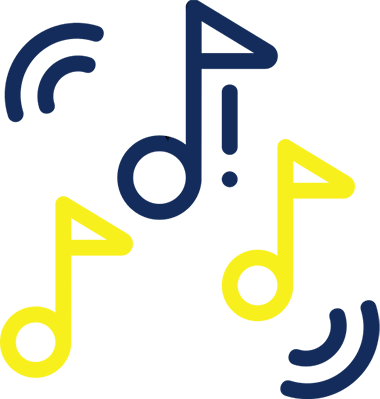
ARRANGEMENT
The Arrangement module includes laying the various music pieces along a timeline to build a final piece of track. The course also includes Ableton Live, which has an Arrangement View to arrange, edit, and finish songs.

DAW
In this module, you will learn the basic features, functions and workflow of DAWs through hands-on training and lectures on basics. DAW module also includes the process of creating templates, recording audio, MIDI, and much more.

RECORDING
Once the song is written, the recording is the next step. The Recording module is based on imparting knowledge about various recording techniques, understanding various tools, and most importantly, the right method of recording.

Sound Processing
Sound Processing involves comprehensive learning about various tools and techniques used for making music. You will learn about equilisation, modulation, delay, reverb, compression, distortion, etc.

SOUND DESIGN
The Sound Design module involves techniques about film scoring and soundtrack work like foley and special effects. Our faculties have a systematic approach for sound designing concepts.

BACKGROUND SCORING
Background Scoring is related to providing background music in films, albums, etc. For students looking to make a career in the film industry, this module will be proven as a milestone to getting familiar with how background music works and the process of music scoring.

SONGWRITING AND LYRICS
The songwriting and lyrics writing is closely knitted with music production. In this module, you will learn through analysis, examples, and sessions to compose songs in different genres. Highlights of this module include basic skills of lyrics writing, arranging your original compositions, and producing them.
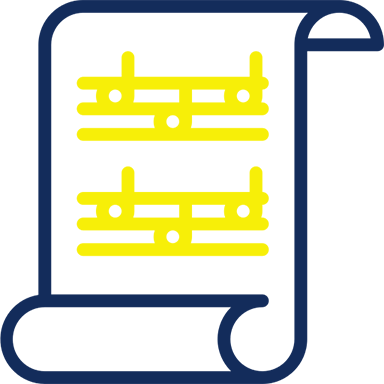
INTRODUCTION TO SOUND
The Introduction module provides introduction to sound engineering concepts like sound theory, terminologies, and other basic knowledge about sound. The module differentiates the difference between sound and music which is a much larger misconception in the students.

BASICS OF ELECTRONICS
The basics of electronics include an in-depth understanding of various electronics of a sound studio and how the instruments contribute towards making the sound.

STUDIO TECHNOLOGY
This module explains the fundamentals of studio techniques such as Quantisation, Sampling, Bit-Depth, Analog-to-Digital Conversion, and Digital Signal Processing. Studio Technology also includes the working principle of various interfaces as well as Software DAW’s.
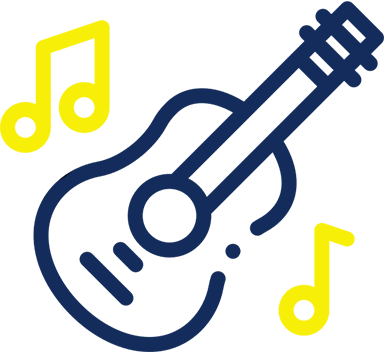
ACOUSTICS
Acoustics is the science of a sound wave’s generation, transmission, reception and its effects. The Acoustics module also covers the aspects of studio design such as room dimensions, soundproofing, isolation with various materials, etc.

MICROPHONES AND SPEAKERS
For sound engineers, knowing the working principle of loudspeakers & its types, basics of amplifier circuits, crossovers and drivers are crucial. This module focuses on understanding specification charts to follow parameters such as amplifier power, sensitivity, distortion, rating, etc.

RECORDING
Recording module develops skills in sound recording and editing multi-track audio using a DAW. A deep study about the DAW tools, its setup, configuration, and settings. Perform recording on various pro tools and understand the technicalities.
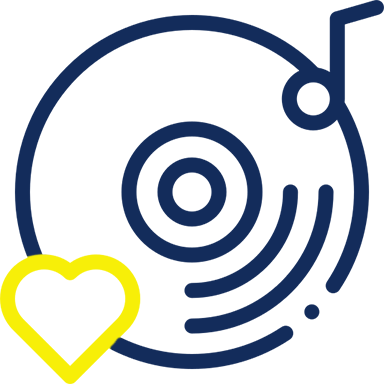
MIXING
After recording the music, it needs to go through the creative process of mixing. The module includes setup, audio editing, vocal editing, pitch correction in the tracks, etc.

MASTERING
Mastering is the process of taking an audio track and preparing it for distribution. In this module, students learn about ‘polishing’ the sound for the final outcome, providing consistency and making it ready for distribution to public channels.
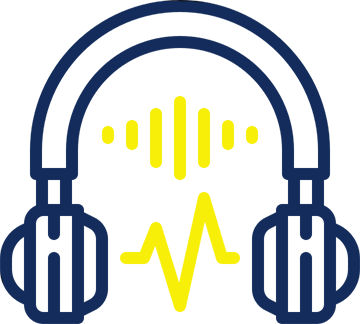
FILM SOUND
The module discusses different film sound workflows used on set or in sound studio and discusses concepts of sync devices, continuity sheets, etc. It also includes concepts of sync sounds and location recording. Students will also learn about various sound recording instruments.
